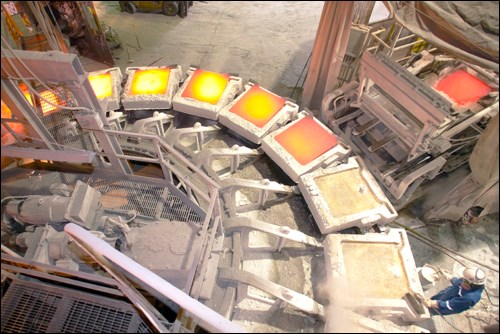A tall, narrow painting clung to the wall behind Peter Jones as he prepared to address an audience at the Friendship Centre restaurant.
The artwork depicted a wholesome blue sky, one free from the smoke clouds characteristic of Flin Flon courtesy of Jones’ company, Hudson Bay Mining and Smelting.
His speech this day, Sept. 13, 2004, would prove to be a case of life imitating art.
Jones, president and CEO of HBM&S, laid it all out. The company, he said, would “more than likely” close its Flin Flon copper smelter at the end of 2008 if new air regulations were brought into force. About 300 jobs would be lost.
Under the proposed regulations for Canadian smelters, HBM&S would be required to cut its sulfur dioxide emissions by 25 per cent. Jones said this wouldn’t be possible without a closure.
As guest speaker at Healthy Flin Flon, a now-defunct series of public forums, Jones seemed rushed, likely with good reason. Around the same time of his speech, a “for sale” sign had been placed on HBM&S.
No sooner had Jones vacated the restaurant as the whispers began. Was he bluffing? Or was this the beginning of the end of those thick clouds of smelter smoke billowing across Flin Flon’s sky?
Signature part
The copper smelter had been a signature part of HBM&S’s Flin Flon operations itself since 1930.
Inside, the smelter relied on a process of heating and melting to extract copper from ore. The resultant pollution – toxic clouds of white smoke – poured out of the tips of two smoke stacks.
Most Flin Flon residents accepted the smoke – and the occasional hacking it produced – as inherent to life in an industrial community.
That attitude began to shift in the 1970s, when HBM&S replaced its two “short stacks” with a tall, single stack designed to more broadly disperse the pollution.
In the 1980s, amid dire warnings of sulfur-dioxide-induced acid rain, the smelter faced further public and government scrutiny. Possible health implications from smelter pollution became a customary topic of conversation.
To be sure, the smelter was meeting pollution regulations. But as those regulations tightened, and perhaps tightened some more, would the smelter endure in the long-term?
Flin Flonners felt conflicted. On the one hand, they worried about the many tonnes of lead, arsenic, mercury and other dangerous pollutants in their air because of the smelter.
On the other, they feared the economic repercussions of relinquishing a facility responsible for nearly a fifth of the jobs bequeathed by their main employer.
Reaction
“Future of smelter in question” read The Reminder’s front-page headline on Sept. 14, 2004.
“Hudson Bay Mining and Smelting anticipates a closure of its smelter in four years if a new federal air regulation is implemented, company president and CEO Peter Jones announced yesterday,” began an article that propelled particularly strong newspaper sales that day.
HBM&S employees reacted with concern, and in some cases anger. To them, the federal government seemed eager to “clean up Flin Flon” in order to score points with environmentally minded voters in urban centres.
Dennis Ballard, then the mayor of Flin Flon, wasn’t buying it.
“You know, surely the government isn’t foolish enough to pass legislation that would shut us down,” he said at the time. “Somewhere along the line, I see the problem is that the legislators pass the legislation and the bureaucrats, I don’t blame them, follow it to the letter, and sometimes it’s just not reasonable. The legislators have to look at both sides, at what is good to have in place and what you can afford to have in place.”
Ballard and his council quickly joined efforts to save the smelter, as did then-MP Bev Desjarlais and other civic leaders.
Quietly, some Flin Flonners felt let down by their representatives’ plan to essentially ask Ottawa to maintain the status quo at one of Canada’s worst air polluters.
As the months went on, however, the smelter announcement dropped from the headlines, particularly after a junior miner called Ontzinc Corp. came out of nowhere to buy HBM&S in late 2004.
A presumption permeated Flin Flon that perhaps Ontzinc, which renamed itself HudBay Minerals, planned to maintain the smelter.
Inevitability
The HBM&S copper smelter continued to puff away throughout the mid-2000s, with parent company HudBay enjoying sky-high profits.
So was the smelter still on the chopping block? Indeed it was, Jones, who was now head of HudBay, proclaimed in late 2007. He said the smelter was set to shut down sometime between 2008 and 2015.
Ottawa had loosened up on its initial smelter regulations for 2008. But beginning in 2015, the smelter would be expected to slash sulfur dioxide output by a remarkable 85 per cent.
Left to defend the regulations was Serge Langdeau, a base-metal smelting program manager with Environment Canada.
“We don’t want to hurt the economy, but on the other hand, we also want Canadian industry to meet some sort of environmental standards that are comparable to what’s being done elsewhere in the world,” Langdeau said.
Whereas some residents seemed to doubt Jones’ first smelter pronouncement of 2004, his 2007 statement carried an air of inevitability.
By this time, HudBay was funding a study to determine the health risks, if any, of the smelter-borne metals that laced the soil in and around Flin Flon.
The study stemmed from provincial government research showing much of Flin Flon’s soil contained elevated levels of metals – a finding that famously prompted the Winnipeg Free Press to label Flin Flon “Toxic town.”
Yet pollution was not the only issue at play. Small, landlocked smelters such as Flin Flon’s were no longer viewed as competitive as the smelting industry shifted to newer, larger facilities with access to waters.
In 2002, Noranda Inc. shut down its Gaspe smelter in Quebec, citing unfavourable economics. Xstrata Copper later shuttered its Kidd Creek smelter in Ontario, while Vale announced its nickel smelter in Thompson would close.
The Flin Flon copper smelter was next. It was only a matter of when.
Awaiting word
HBM&S smelter employees were on edge throughout 2008 and early 2009, awaiting word as to when their workplace would wind down.
On June 18, 2009, HudBay Minerals ended the guessing game. A company news release revealed the smelter was set to close by July 1, 2010. An estimated 225 jobs – lower than initial projections – would be lost.
“The Flin Flon copper smelter has been a great asset and one of the centerpieces of our operations for over 80 years,” Jones said in the release.
On May 28, 2010, HBM&S narrowed down the closure date further with an employee bulletin. All of the “necessary elements” were place to operate without the smelter. Smelter operations would cease on June 11, 2010.
At 3:30 pm on June 10, 2010, the last copper charge was removed from the smelter’s converters. The final puffs of smoke emitted from the stack. The last anode cast was completed the following afternoon. It was all over.
The economic impact of the closure was far less severe than some had feared. HBM&S initially laid off 26 workers. A year after the closure, only seven of those people were no longer employed by the company, which offered all impacted workers other jobs within its operations.
Layoffs were limited by virtue of 100 workers who accepted retirement packages from HBM&S – a step that earned praise even from those normally antagonistic toward the company.
Out of the copper smelting business, HBM&S constructed a filter plant to reduce moisture in its copper concentrate, making it lighter and thus more economical to ship to other smelters.
Legacy
After the copper smelter closed, questions remained about its legacy of metal-contaminated soil.
HudBay had funded a years-long study to examine the potential health implications of those metals. In May 2013, the final results were published.
The Flin Flon Soils Study, as it was known, concluded the metal-laced soil posed virtually no health risks to area residents.
“You can never say there’s zero risk, but it’s essentially zero,” said Elliot Sigal, one of the scientists behind the study.
As for Hudbay (the “B” now lower-cased), the company made it clear its days of smelting copper were unquestionably over even as the new Lalor and Reed mines were readied for production.
Copper smelting had served Flin Flon and its main employer for decades, but it no longer made sense, environmentally or economically.
Just like the painting behind Peter Jones that afternoon in 2004, Flin Flon’s skyline was free from smoke – for better and for worse.




